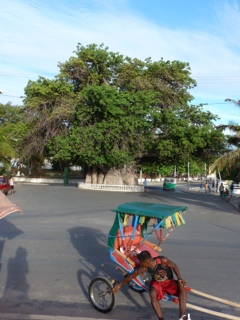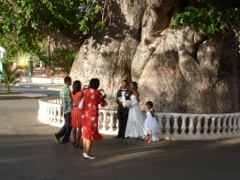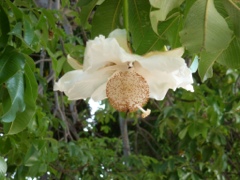Mahajanga’s ‘Grand Baobab’
The ‘Grand Baobab’ of Mahajanga (Majunga), the old port on the west coast of the island, is an important symbol of the city and the region. Mahajanga has been a major commercial port since 1745 and was likely an important port for Arab dhow traffic long before that. The Grand Baobab is situated where two wide waterfront boulevards meet a major avenue and functions as the centre of a large traffic roundabout. It appears to be a major focus of the city with people almost always sitting under it or sitting on the sea wall watching the changing light in the cool afternoon sea breeze. One afternoon we saw three wedding parties noisily honking their way down the avenue and around the tree, stopping for what appeared to be obligatory photos in front of the tree. A symbol of longevity?
Sarah and I measured the circumference in 1979 as 20.6 m (breast height). Mischa and I measured it again this December as 20.7 m. Not much growth in 32 years! Is there a maximum size for such a tree under given climate conditions or does the pavement (blacktop) and auto traffic tell part of the story? We found an old postcard in the museum which recorded the diameter in 1898 as 14.6 m, so there had been significant growth in the 80 odd years before our first visit.
The ‘Grand Baobab’ is said to be about 700 years old, though I doubt that anyone has scientifically aged it. It is not the only large baobab in Mahajanga. Another impressive Adansonia digitata is to be found in a private yard behind a bank in the commercial centre of town. It was in full bloom when we were there, the flowers busily visited by honey bees for both pollen and nectar. Other trees of different ages can be found at various locations around town. They all appear to be the African species, A. digitata. Analysis of the chloroplast DNA indicates that these Malagache digitata are genetically identical to those of eastern and southern Africa, so they were probably brought by seafaring traders across the Mozambique Channel.
There are apparently some much larger and older A. digitata farther north on the Analabe peninsula that carry a mutation which indicates that they originated from baobabs whose fruit floated over from Africa before the island was populated by Homo sapiens. This would indicate that there have been at least three introductions of baobabs to Madagascar over the millennia. I would love to see these remarkable trees in their setting which is apparently largely undisturbed. Perhaps I’ll be able to organize it on some future visit to Madagascar.
Chloroplast genetics work conducted by CIRAD scientists strongly support the hypothesis that baobabs originated in West Africa and spread across the continent when suitable climatic conditions existed, evolving slightly different sub groups as populations became isolated by unsuitable climatic conditions. At some point the ancestor or ancestors of the Madagascar baobabs drifted over the channel and, in the new island environment, were subject to the phenomenon of adaptive radiation that lead to the 6 indigenous species found there today. I’ll discuss the whole question of island biogeography and baobabs in a future contribution.
Photos
‘Le Grand Baobab de Mahajanga’
Social life at the Grand Baobab
Distribution of A. digitata chloroplast DNA halplotypes (from Pock Sty et al.)




Leave a Reply